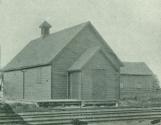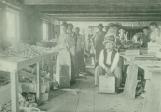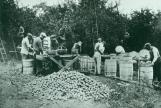1
PRE-COOLING FRUIT AND COLD STORAGE EXPERIMENTATION STATIONSShipping fruit, whether to the local grocery store, the processing plant or overseas, meant that certain measures needed to be taken to ensure that the fruit arrived as fresh as possible without being bruised or spoiled. Cooling the fruit was a great way to slow down this ripening process. Fruit was stored in cooling warehouses before being taken to the markets for sale or before shipping to a processing plant. The fruit cooling stations were essential to the expansion of Grimsby and the town's importance in the fruit industry.
2
FIRST COLD STORAGE PLANT BUILT IN GRIMSBYIn the mid-1890's Linus Woolverton and a group of local fruit growers, assisted by the Dominion Department of Agriculture built a cold storage facility in Grimsby to hold approximately one and a half carloads of fruit. The facility was located on Ontario Street north of the Grand Trunk Railway tracks. The facility was a small building filled with ice in the back two thirds. There were openings at the bottom of the partition which allowed the currents of cold air to flow from the ice out into the storage room. Flues in the ceiling allowed the warm air to circulate back to the ice room. When the building was no longer in use, it was relocated to Robinson Street North and was later destroyed by fire in August 1936.
3
First Grimsby Experimental Cold Storage Facility19th Century, Circa 1897
Grimsby, Ontario, Canada
 Credits:
Credits:Grimsby Museum Collection
4
To test the benefits of cold storage the fruit growers planned to send, on a weekly basis, a car-load of fruit to Great Britain. The shipments were to include summer apples, tomatoes, pears, peaches and grapes. The results from this experiment were to be shared with the public as quickly as possible to allow the entire country the benefit of shipping produce overseas.5
In the "Canadian Horticulturist" of 1897 Linus Woolverton writes:"One of the most encouraging prospects now before the Ontario Fruit Grower is that of soon being able to export to Great Britain in perfect cold storage his choicest fruits. This season our fruit growers have waked up to the possibility of over production of some of our finest fruits. Our magnificent Bartletts ( Pears) have been begging for buyers at 25 cents a twelve quart basket, beautiful Concord grapes at one cent a pound, Lombard plums at 15 cents a twelve quart basket, and our world renowned apples at 40 cents a barrel!"
6
Packing Fruit For England19th Century, Circa 1897
Grimsby, Ontario, Canada
 Credits:
Credits:Grimsby Museum Collection
7
Cold Storage Cases19th Century, Circa 1897
Grimsby, Ontario, Canada
 Credits:
Credits:Grimsby Museum Collection
8
Cold Storage Trays to be Inserted into Cases19th Century, Circa 1897
Grimsby, Ontario, Canada
 Credits:
Credits:Grimsby Museum Collection
9
The First Shipment of Grimsby Peaches and Bartlett Pears to England1897
Grimsby, Ontario, Canada
 Credits:
Credits:Grimsby Museum Collection
10
Even in 1897 farmers were aware that warm temperatures caused damage to their crops while being shipped over long distances. The "Canadian Horticulturist" of 1897 described the reasons for pre-cooling fruit before shipment:"One of the essential conditions, for the safe carriage of the tender and easily injured fruits, is that they should be thoroughly cooled before they are put into the railway car. If they are cooled to a temperature of 35 or 36 degrees Fahrenheit practically all fermentation will be stopped, and the boxes of fruit will not generate heat by their own ripening. When the fruits are put into cases warm, and these are put directly into a car, the ripening of the fruit generates heat."
11
Following the success of the initial 1897 shipment fruit from Ontario continued to be shipped to Great Britain. In his 1910 book "The Canadian Apple Grower's Guide", Linus Woolverton explained the process of packing apples in barrels for overseas shipment."In packing the barrel average samples of good colour are selected and placed to cover the bottom, which will be the head, with stem end down beginning with a row all around against the side; then, a second layer is placed in the same way, but so as to cover the openings between the apples of the first layer, after which they may be allowed to go in freely from the packing table. Some careful packers remove the stems of the first layer with pincers lest they press into the flesh and injure it. For high-grade apples a fine effect may be had by first lining the head with lace paper before beginning to pack the barrel."
"The packer will take care to give the barrel an occasional shake during the filling and often pack the apples in their places by hand to make them lie close. With care in these particulars it will not be necessary to fill the barrel more than about an inch or two above the chime so that a gentle pressure with the apple press will bring the head to its place without bruising the fruit. Carelessness in this particular has often depreciated the value of the fruit one-third. Some packers use a paper pad at each end of the barrel to relieve the apples of the direct pressure."
"Several styles of presses are offered for sale for use in heading barrels. The lever press, which is operated and held in place by one foot, is quick and convenient; but some packers prefer the screw press, which holds the head in place without effort. With this an iron circle press head is used, or a press block of heavy wood resting upon the barrelhead."
"A cooper's mallet and wooden chisel should be used in driving down the hoops to their places, after which the press is removed and the head lining placed as previously described."
"The barrel should then be at once turned down side up, and the name of the variety and grade plainly stamped upon it, leaving room for the shipping mark and the name of the shipper."
12
Coopers Tools and Screw Barrel Press1910-1925
Grimsby, Ontario, Canada
 Credits:
Credits:Grimsby Museum Collection
13
Packing Apples In Barrels20th Century, Cira 1900
Grimsby, Ontario, Canada
 Credits:
Credits:Grimsby Museum Collection
14
THE SECOND GRIMSBY PRE-COOLING STATIONOn October 29, 1913, the "Grimsby Independent" officially announced the construction of the second Government Pre-cooling Station in Grimsby. It was built on Livingston Avenue by Daniel Marsh and Sons, a local Grimsby firm. In 1914, the Department of Agriculture opened the Experimental Pre-Cooling and Fruit Storage Plant at Grimsby, Ontario. Once the fruit storage warehouse was in use, it was said that thirty-nine cars of pre-cooled fruit were handled and assembled over three or four days.